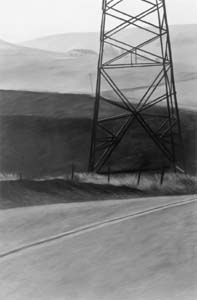California Dreaming
Artists redefine the lay of the Golden State at Triton Museum
By Ann Elliott Sherman
LIKE THE REAL and mythic dimensions of the Golden State itself, California Landscapes: An Urban/Rural Dialogue is a diverse show threatening to sprawl beyond the confines of the Triton Museum's two galleries and outsized foyer.
Among the 43 participating artists, a loose kind of categorization can be discerned: there are those who directly address the effects of urbanization and/or technology upon the California environment; some who include evidence of that interface without comment; and others who present an idealized or internalized image of the landscape.
Appropriately, there is no artificial attempt to order or separate all these vantage points. William Henry Hill's iconic, circa-1900 photographs of Southern California palms, eucalyptus and cacti butt up against contemporaneous chronicles of logging's destruction of primeval redwood forest in sepia-toned silver-gelatin prints by Andrew Putnam Hill.
And on the next wall, Tim Goodman's wryly affectionate Rancho Deserta photographic series demonstrates the indefatigable glory of desert light prevailing over all human attempts to claim or transform that place.
Valerie Jacobs points to the Absolute Landscape's by-now-imaginary status by repeatedly silkscreening the outlined image of a brain over the foreground of a traditional rural landscape. More bluntly, she frames an oil painting of a fiery Bayview-Hunter's Point sunset with an altar of street trash, confronting the duality of the urban landscape's sublime and decidedly less romantic aspects.
Her partner, Kevyn Lutton, paints an allegorical view of the neighborhood around 3Com Park in the Romantic style, with three youths celebrating a hip-hop Morris dance beneath blossoming trees despite the raven watching from atop a gallows.
Among the artists who include the man-made within the landscape without editorializing, the subject often becomes the play of light at that particular time and place. Stanley Goldstein's work sits somewhere between photorealism and plein-air painting in its obsession with sunlight and shadow, whether falling on a stucco house in 22nd at Collingwood or the silos and furrows along I-5.
Jessica Dunne updates her views of dramatic sunsets around the bay by making the car windshield her frame of reference, the way Californians most often experience such vistas. A serpentine of taillights, illuminated exit signs and streetlamps reflected in a swell of fender or a metallic-ribbed bus becomes as much a part of the scene as the Golden Gate or skyline.
Anne Subercaseaux's series of oils finds poetic equivalency in rolling hills and revolving windmills. The most arrestingly composed of her pieces, Transcendence/Transformation, is divided into thirds: midtone gray two-lane highway spliced by the double yellow line; scorched field edged in rusty weeds; misty hills with a house and windbreak nestled under the pearl-gray sky. Smack in the foreground of this lovely view, just off-center, stands the derrick of an electrical transformer tower so massive that the top rises unseen off the canvas.
The tower, which might conventionally be viewed as an intrusion, is actually the only object capturing the downcast glints of light that lend the sense of otherworldly power within the ordinary that earns the painting's title.
THE LAST GROUP--ideal or internalized landscapes--ranges from Pat Sherwood's Diebenkorn-like abstracts to Ann Thiermann's pastels in which the blues rival anything Maxfield Parrish might have dreamed up. Sam Morse captures the essence and effect of Benicia Clouds with a clarity of form, color and vision usually lost somewhere in childhood.
Others stretch the genre far into other media. Linda Hansen Mau's Garden Sentinels is an "urban meditation garden" composed of scored ceramic pods rising from a bed of raked, coarse sand. In her sculpture Cuerpos Y Sacos (Bodies and Sacks), Norah Hernandez alludes to the physical diversity of the human landscape with biomorphic shapes formed from burlap sacks and given papier-mâché skins of varying thickness, texture and pigments.
Despite all the talk about diversity, here in the Bay Area it's sometimes easy to forget that California has always held wildly divergent extremes within its embrace. It's good to get a glimpse of even part of the lay of the land.
[ San Jose | Metroactive Central | Archives ]
Copyright © Metro Publishing Inc. Maintained by Boulevards New Media.
![]()
 Otherwordly Power: Anne Subercaseaux's oil 'Transcendence/Transformation' plays on the contrast between a rural vista and a man-made electrical transformer tower.
Otherwordly Power: Anne Subercaseaux's oil 'Transcendence/Transformation' plays on the contrast between a rural vista and a man-made electrical transformer tower.
California Landscapes: An Urban/Rural Dialogue runs through May 10 at the Triton Museum of Art, 1505 Warburton Ave., Santa Clara. (408/247-3754)
From the March 12-18, 1998 issue of Metro.
![[Metroactive Arts]](/arts/gifs/art468.gif)